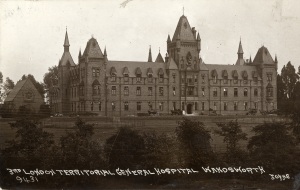The meeting of the Board of Guardians on 17 September noted that 37 of their staff had joined up so far. Those who had joined up were mostly going to the Royal Army Medical Corps or Nursing, with some others joining the TA, Army, Marines and Navy. Generally when thinking of the staff employed by the Board of Guardians you might think of those who ran the Swaffield Road Institution (formerly known as the workhouse), but the Wandsworth and Clapham Union also ran hospitals – St James Infirmary in Balham, St Johns Infirmary on St Johns Hill and the Tooting Home on Church Lane. Staff volunteering for nursing and the RAMC means we can divert slightly away from precisely what was happening in the borough this week and look at an institution that had been developing since the outbreak of war – the 3rd London General Hospital.
The 3rd London was based in what had been the Royal Victoria Patriotic Asylum, a school for the orphaned daughters of servicemen on Wandsworth Common. When war broke out the building was requisitioned and work began to transform it into a hospital. From 1915 the Hospital began publishing a magazine, and both the Commanding Officer (CO) and the Assistant Matron wrote about their experience in setting it up. Four General Hospitals were to be set up in London and officers involved came from the staff of other London hospitals – for the 3rd London, they came from the Middlesex, St Mary’s and University College Hospitals. The CO writes in 1915 that when the order to mobilise came very little was known and “the only safe course appeared to be to act first and to get authority afterwards”. The school had to be emptied and equipment acquired, including getting the only X-ray machine on the market in London – normally these came from Germany but this was obviously impossible and it would be some time before they could get them from America. Much of the equipment ordered was for a Field Hospital and the 3rd London had different requirements so supplies were starting to run short. The CO describes being given 150 beds, which turned out to be bunks for temporary use in times of strike and not suitable for a hospital. By ten days after the mobilisation order 520 beds were ready – 350 of which were actual beds and the rest mattresses on the floor. Operating theatres were ready and most of the staff were there.
The staff coming to the hospital also had to ensure that the school was fully moved out. The chapel was turned into a store-house, and lockers cleared out into carefully bags to ensure that children’s toys were not lost. Huts were built to act as additional wards, and after eight weeks of work there was space for 520 actual beds. The staff came from a wide range of professions – teachers, actors, dentists, a retired professional boxer, painters, a theatre carpenter – and were all either unfit for active combatant service or were over the age of enlistment. Nurses were found local accommodation, with the help of Captain Dodson, who had formerly been the doctor for the Patriotic School.
The first patients arrived on 25 September 1914, so in this week in Wandsworth the 3rd London General Hospital was very much still preparing for what was to come.
Copies of the 3rd London Hospital Gazette ar at Wandsworth Heritage Service.

Very interesting!
Pingback: 12-18 January 1917: Putney Relief Fund | Wandsworth 1914-1918
Pingback: 5-11 October 1915: the First Edition of the 3rd London General Hospital Gazette | Wandsworth 1914-1918